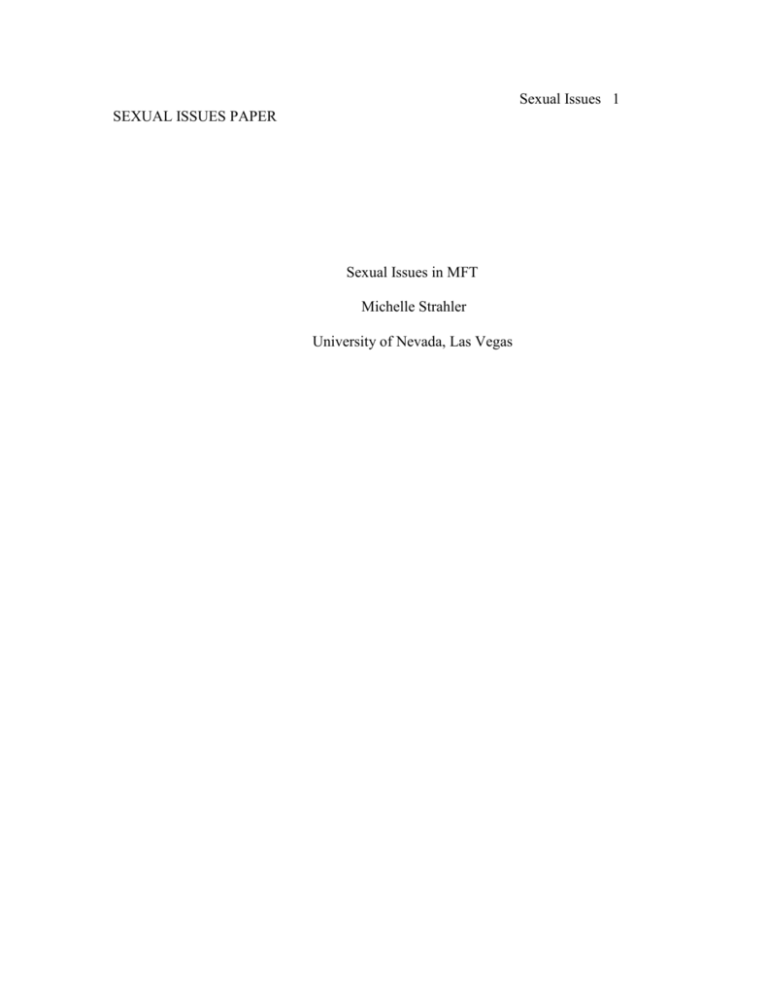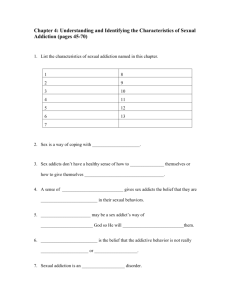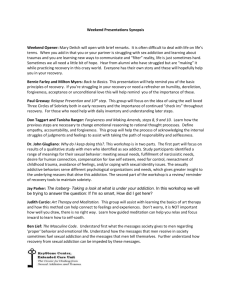
Sexual Issues 1
SEXUAL ISSUES PAPER
Sexual Issues in MFT
Michelle Strahler
University of Nevada, Las Vegas
Sexual Issues
2
The topic I chose for my paper is “Sexual Addiction” because a friend whose
husband I know has the issue and her husband is recovering with the help of therapy
and Sex Addicts Anonymous. Sexual addiction or compulsive sexual behavior, which
can be used interchangeably according Eli Coleman, is defined as “when sex can be
taken to its obsessive and compulsive extremes.” Sexual compulsions and obsessions
are distressing, recurrent, and interfere with daily functioning. Many people suffer
with these troubles but finding agreement about them among sexual scientists or
treatment professionals is not easy. This often makes it more difficult for those
suffering from compulsive sexual behavior or sexual addiction to get the help they
need (Coleman, 1992).
Sexual addiction, although not as obvious as addiction to drugs or alcohol, can be
just as fatal. Its onset is normally early adolescence, prior to the surfacing of substance
abuse. The family history of a sex addict often reflects conflicting rules, little
intimacy, high expectations, poor supervision and an intergenerational history of
addictions. In such families, children are often neglected, harmed, or exploited; thus,
they are susceptible to sexual and other kinds of abuse by those within or outside of
the family. They unintentionally find addiction as a means to cope with their physical
and emotional wounds (Turner, 1995).
“Disagreement exists as to whether CSB- compulsive sexual behavior is an
addiction, psychosexual development disorder, an impulse control disorder, a mood
disorder or an obsessive-compulsive disorder” (Coleman, 1992).
Sexual Issues
3
Patrick Carnes popularized the idea of CSB as an addiction. He believes that people
become addicted to sex in the same way they become addicted to behaviors or
substances. However, many argue the suggestion that you can become addicted to sex
in a similar way that someone becomes addicted to drugs or alcohol ( Coleman 1992).
Carnes also provides an operational definition of sex addiction as “a pathological
relationship” with a mood-altering experience. The concept of sexual addiction is
sometimes confused with the positive, satisfying, and extreme sexuality enjoyed by a
“normal population”. It is also sometimes confused with simply enjoying frequent sex
as what’s “frequent” to some is the norm for others. Also, many people experience
what they would term sexual overindulgence. But, they learn to moderate the
behavior. They are able to discontinue the behavior and say no. Sex addicts have lost
control over their ability to choose. Their sexual behavior is part of a cycle of thinking,
acting, and feeling which they cannot control. Contrary to enjoying sex as a selfvaluing source of physical pleasure, the sex addict has learned to rely on sex for
comfort from hurt, nurturing, or relief from anxiety, etc., the way a drug addict relies
on drugs, or an alcoholic relies on alcohol (Carnes, 1989).
Addicts use imaginative energy to attain consistent levels of arousal, different
sources of stimulation, and a focused frantic drive to escape from reality. This process
results in a large number of behaviors Carnes (1983; 1991) organized over a hundred
sexual behaviors into eleven general categories. It must be stressed, however, that
while seemingly sexual, the behaviors in each category are more related to power than
sex. Sex is the means to feeling power and control. Most sex addicts engage in at least
Sexual Issues
4
three preferred behaviors, one of which is usually compulsive masturbation enhanced
by pornography and/or fantasy (Turner, 1995).
In most of the literature I read it seems that on the topic of sexual addiction
/compulsive sexual behavior, counselors and therapists have to watch for the
possibility of overpathologizing the disorder. This, according to Eli Coleman, is “one
of the main criticisms given by those who not believe in the idea of compulsive sexual
behavior as a disorder. The pathologizing of sexual behavior may be driven by antisexual attitudes and a failure to recognize the wide-range of normal human sexual
expression.” This caution is central when determining whether a person is engaging in
compulsive sexual behavior. It is important for professionals to be comfortable with a
wide range of normal behavior- both in types and frequency. Occasionally individuals
with their own restrictive ideals will diagnose themselves with this illness, creating
their own distress. Therefore it is very critical to differentiate between individuals who
have a values conflict with their sexual behavior and those who participate in
obsessive sexual behaviors (Coleman, 1996).
Patrick Carnes states “In the convoluted domain of sexual addiction, the power of
popular myths, cultural practices, moral precepts, legal consequences, and theoretical
orientations combine to distort an disguise the problem. This means that therapists who
hope to help sex addicts need to do professional soul searching of their own beliefs.” He
also describes what obscures the therapist’s ability to understand sexual addiction and
what limits are to be faced in working with sexual addicts. That there are three problems
Sexual Issues
5
which are obvious. First, the addict’s humiliation and concealment limit the therapist’s
access to information. Second, sufficient concepts are lacking to help understand addicts
and their families. Third, professional bias-the therapist’s personal belief system- may
hinder a comprehensive picture of the addict and the addictive system (Carnes, 1983).
From my readings and what we have learned in class as therapists we have to be
really careful about our own judgments regarding sexual behavior. I think one of the
biggest factors in defining whether a person has a sexual addiction/ compulsive sexual
behavior is if it interferes greatly with their lives and their relationships. It seems if it
is truly a sexual addiction that will be revealed through behavior.
The research on the topic is mainly related to treatment. However, in looking at
prevalence, according to Dr. Michael Johnson “About 80% of Sex Addicts experienced
some form of child abuse in their developmental years.” Sex addiction is more prevalent
than one would anticipate; possibly four out of ten adults in our society may be sexually
addicted In looking at incidence a conservative estimate of those who could meet the
criteria for sexual compulsivity is about 3-5% of the United States population. This is
most likely a very moderate estimate, since these numbers are based on individuals who
seek treatment. Based on drug and alcohol statistics, we do know that more people suffer
from this problem, than actually seek treatment. These percentages are based on what we
presently understand sexual addiction and compulsive sexual behavior to be, and must
not be interpreted as fixed truths (Carnes,1991). Regarding treatment, Carnes would say
“we now begin with the premise that sex is “good,” not a “moral problem.”
Sexual Issues 6
One primary goal of treatment is to help the addict reclaim a healthy and vibrant
sexuality. In fact, one of the foremost obstacles to that goal in therapy is overcoming all
the negative and moralistic myths which have entrapped the addict’s belief system. The
concept of sexual addiction is not a contemporary version of nineteenth-century
moralism. Treatment goals become clearer when sex addiction is compared with eating
disorders. When patients enter treatment for compulsive overeating, they do not give up
eating. Rather, they learn to eat different foods, to use different rituals, to monitor their
feelings, and to change their attitudes and beliefs about eating. Food becomes positive
and life- enhancing rather than self-destructive.
Of course, the purpose of treatment is not to create superficial change. The overweight
person who compulsively diets only to regain the weight is all too familiar. Similarly, sex
addicts who go into de-escalation (the sex addict’s “diet”) never lose their obsession and
are extremely vulnerable to continuing the illness. The purpose of treatment must not be
to push the addict into de-escalation, but rather to bring about a shift of beliefs and
behavior in which the behavior loses its power (Carnes, 1994)
Research includes The society for the Advancement of Sexual Health
(SASH), which is the organization that addresses sex addiction. SASH has an excellent
journal dedicated to this topic, The Journal of Sexual Addiction and Compulsivity, which
is published quarterly by Taylor and Francis. Patrick Carnes, Ph.D. continues to do
clinical research on all sex addicts and partners who come to Treatment at Pine Grove in
Mississippi and encourages therapists treating this population to collect data. Related
Sexual Issues 7
research on disorders of sexual desire is being conducted at the University of
Pennsylvania by Anna Rose Childress, Ph.D. using functional magnetic resonance
imaging (FMRI). This “brain mapping” determines which parts of the brain are activated
by different types of physical sensation or activity. Currently, Dr. Childress focuses
primarily on substance abuse craving, but hopes to expand to other addictions. Vanderbilt
University also uses FMRI to study sexual arousal specifically in new addicts. Despite its
prevalence, there is still not enough interest from the general public to support this kind
of research. Those suffering from sexual addiction have been the real pioneers in
reaching out for help and teaching the professionals what they know. “They deserve help
not only for their own pain but also for the advancement of sexual health in our culture.
This will result in better treatment of our children in the future. Moreover, healthy
courtship and proper parenting should be required courses in educational institutions for
children and adults (Turner, 1995 p. 118).
It seems that Patrick Carnes, Ph.D. is recognized as the leading expert in the field of
sexual addiction. He is Clinical Director of Sexual Disorders at The Meadows, a
treatment facility that works with clients who deal with a range of behavior disorders,
addictions and psychological conditions. He is also the author of several books including,
Out of the Shadows: Understanding Sexual Addiction and Contrary to Love: Helping the
Sexual Addict.
Other Authors are John Cheever who wrote Oh What a Paradise It Seems, and, John
Bancroft “Hormones and Sexual Behavior, Medical Aspects of Human Sexuality.
Sexual Issues 8
Martha Turner wrote the article “Uncovering and Treating Sex Addiction in Couples
Therapy. These are some of the many people who have written about sexual addiction.
Regarding Treatment options, while a difference of opinion exists about the nature of
CSB, treatment professionals have generally found a combination of psychotherapy and
prescription drugs to be effective in treating sexual addiction. While medications which
suppress the production of a male hormones (anti –androgens) are used to treat a variety
of paraphilic disorders, newer anti-depressants such as Zoloft ®, Prozac ®, or Paxil ®
which selectively act on serotonin levels in the brain are also effective in reducing sexual
compulsions and obsessions and their connected levels of depression and anxiety. These
recently made medications interrupt the obsessive-compulsive cycle of CSB or sexual
addiction and help patients use therapy more successfully (Coleman, 1992).
In looking at couples, sexual addiction is ingrained in the fabric of the couple’s
intimate relationship. The treatment of sex addiction is growth –oriented; partners are
helped to defeat their problems but also to optimize their relationship. The purpose of
treatment is healthy sexuality in a committed relationship and a quality of life that
encourages success on all levels for both (Turner, 1995)
Carnes believes that Twelve-step programs which have a spiritual component such as
Sex and Love Addicts Anonymous (for the individual), Sexual Compulsive Anonymous
(For gay and lesbian people all over the country) and Sex Anon (for the families of sex
addicts) are some of the best recovery programs with the best success. These programs
Sexual Issues 9
along with individual or couples therapy often combined with medication seem to be the
best form of treatment. Treatment may be ineffective if the person with the addiction
does not want to give up the addiction, do the work involved with a treatment program or
Twelve- step program or if they are required to take medication and don’t or if they don’t
follow- through with therapy.
Sexual Issues
10
References
Carnes, P. (1983). Out of the Shadows: Understanding Sexual Addiction. Minneapolis,
MN: CompCare Publishers.
Carnes, P. (1989). Contrary to Love: Helping the Sexual Addict. Center City
MN: CompCare Publishers.
Coleman, E. (1992). Is your patient suffering from compulsive sexual behavior?
Psychiatric Annals, 22 (6), 320-425.
Johnson, Michel (2007). The Origins of Sex Addiction. Retrieved November 12, 2007
From www.Sexual addict.com.
Turner, M. (1995). Addictions in marital/relationship therapy. In G.R. Weeks.., & L.
Hof (Eds.). Integrative solutions: Treating common problems in couples therapy (pp.
124-147). New York: Brunner/Mazel.








